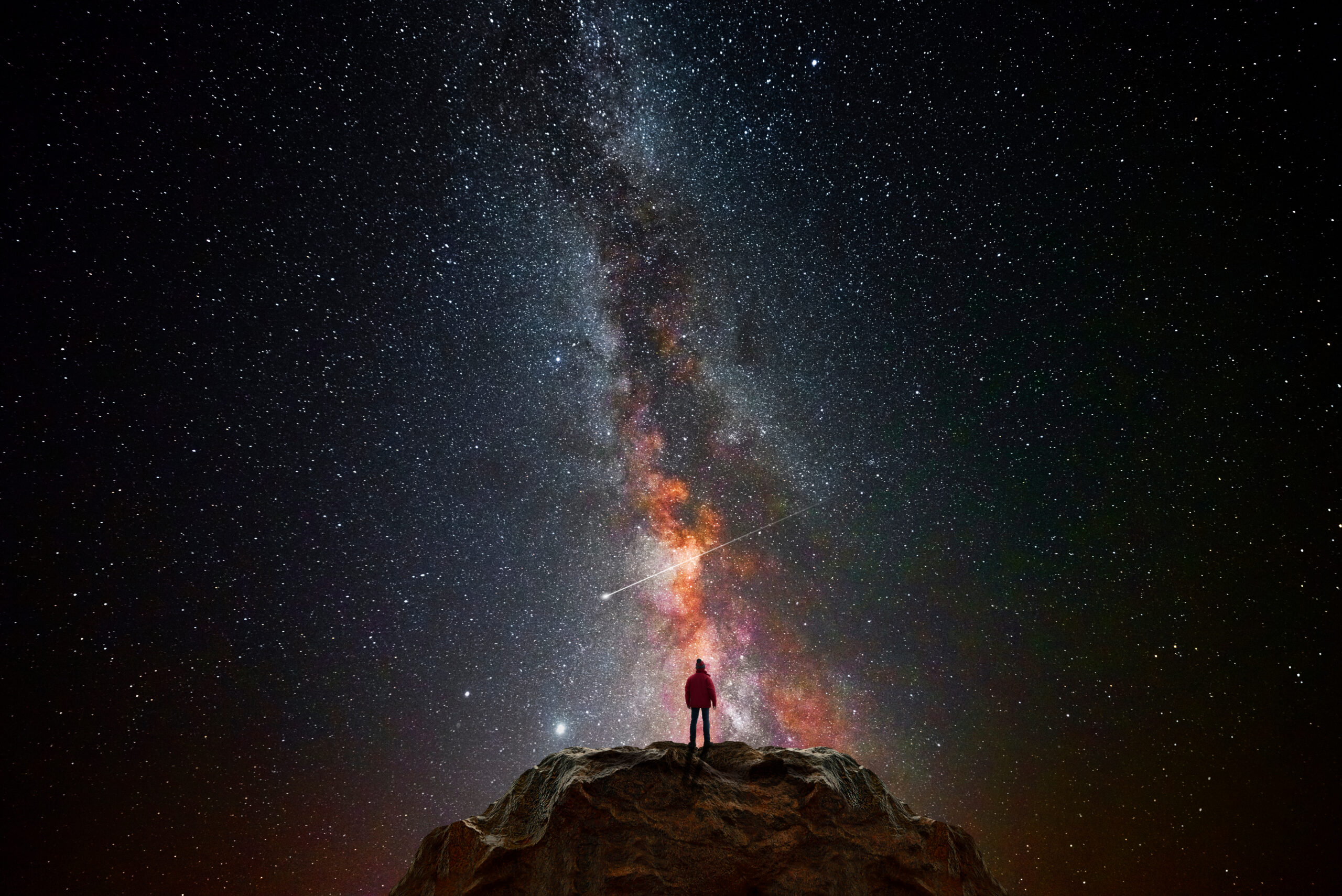The Atoms in Your Body Were Once Interstellar Cosmic Dust Drifting Between Galaxies, New Research Shows

The atoms that make up your body have a story to tell, a story that stretches far beyond the Earth. They’ve traveled across galaxies, moved through vast cosmic currents, and endured the fiery explosions of stars. Long before becoming part of you, these atoms, including the carbon that forms the backbone of life, spent millions of years drifting through intergalactic space.
Recent research reveals a stunning truth: the very atoms in your body, the ones that allow you to breathe, think, and move, were once part of a cosmic “conveyor belt.” This new discovery shows that elements like carbon, which were once thought to be too light to travel through space, are actually carried by currents that move material between galaxies. Before returning to our own, these atoms experienced a journey beyond what we could ever imagine.
The Cosmic Conveyor Belt – A New Discovery

For years, scientists believed that atoms, once expelled from dying stars, simply drifted aimlessly through space. Heavier elements like oxygen and iron were known to be ejected by supernovae—stellar explosions that send matter hurtling out into the cosmos. However, lighter elements, particularly carbon, were thought to be too fragile to travel beyond their home galaxy.
But recent discoveries have turned that assumption on its head. Using data from the Hubble Space Telescope, researchers have confirmed that carbon is not only present in the vast cosmic currents known as the circumgalactic medium, but it is also one of the most abundant elements in these intergalactic flows. This cosmic “conveyor belt,” a massive network of currents moving material between galaxies, acts as both a recycling system and a conveyor for new materials, fueling the ongoing cycle of star and planet formation.
Carbon, the very element that forms the backbone of life as we know it, has spent a significant amount of time drifting through these cosmic currents before returning to our galaxy. The research shows that this isn’t just an isolated case but a process that involves many of the elements in our bodies. From oxygen to iron, much of the material we consider essential for life has traveled a vast, complex journey through the cosmos before it was incorporated into our solar system and, eventually, into us.
Our Journey Across Time and Space

Now, picture those very same atoms—carbon, oxygen, nitrogen—coming together in the formation of Earth. Over billions of years, these cosmic travelers have been incorporated into the building blocks of life itself, eventually forming the planet we now call home. They’ve played a part in every living organism that has ever existed, from the earliest single-celled life to the human beings we are today.
What’s extraordinary is that the very atoms that make up our bodies were once part of a different time and place—fated to be something entirely different. These atoms were forged in the hearts of dying stars, then scattered through the universe before finally being absorbed by new celestial bodies. Now, they are part of you, part of your story. You didn’t simply come into being by chance; you are the result of a long, cosmic journey that started long before your birth.

Science, once again, reminds us of the awe-inspiring truth: you are stardust. This realization isn’t just poetic or metaphorical. It’s a scientific fact, backed by groundbreaking research that uncovers the intricate history of the atoms in our bodies. When you consider this, you can’t help but feel a sense of awe at the forces of nature that have allowed your existence.
The atoms that make you, that make life possible on Earth, have seen the birth and death of stars, have traveled vast distances, and have existed in places beyond our comprehension. They’ve crossed galaxies, interacted with nebulae, and formed new stars—each step in this journey bringing them closer to the moment they would become part of you. And perhaps, it’s this connection to the vast, infinite universe that offers us not only understanding of who we are, but a deeper sense of purpose in this great cosmic story.
The Importance of Understanding Our Cosmic Origins
So, why does it matter that we are made of ancient stardust? It’s not just a fun fact to ponder during a quiet moment; understanding our cosmic origins carries profound implications for how we see ourselves, our world, and our place in the universe.
For one, it challenges our sense of separation. We often think of ourselves as small, individual beings navigating a vast and indifferent universe. But when you realize that the very atoms in your body once traveled across galaxies, existing long before you were born, it paints a picture of interconnectedness. You’re not just isolated in your experiences; you are part of something much bigger. You are a living, breathing expression of the universe itself. The sense of awe that this brings can shift how we relate to our own lives, other people, and the world around us.

On a more personal level, understanding our cosmic origins can also offer a sense of humility. The universe, with its vastness and complexity, is so much larger than we can truly comprehend. Yet, we are not excluded from it. We are made from the very same materials as the stars, and in that, there’s both a humbling and empowering truth: we are not just fleeting beings passing through—we are the result of the universe’s ongoing process, a process that has lasted billions of years.
This knowledge doesn’t just help us see ourselves in a new light. It can also change the way we approach life. When we recognize the extraordinary journey our atoms have taken to form us, we may feel inspired to live with a greater sense of purpose, to care more for the planet that sustains us, and to cherish the brief time we have on Earth. We are part of a grand, cosmic cycle—a cycle that’s been in motion for eons, and will continue long after we’re gone. Understanding that helps us see life not just as a series of isolated events, but as part of a much larger, ongoing story.
From Interstellar Dust to Actionable Change

Now that we understand our connection to the cosmos, how do we translate this knowledge into meaningful change in our own lives and in the world around us? If we truly are stardust, how can we use that understanding to impact our actions, relationships, and the planet?
First, this cosmic perspective encourages empathy. Realizing that the atoms in our bodies have crossed paths with those of others, connecting us in ways beyond what we can see, might inspire us to treat others with more kindness and understanding. We’re all made of the same material, after all. This interconnectedness invites us to look beyond our differences and to recognize our shared humanity, which can foster greater collaboration and peace in our communities.
On a broader scale, understanding the cosmic journey of our atoms also pushes us to rethink our relationship with the Earth. Just as our atoms have been recycled over eons, the environment too must be cared for, preserved, and sustained. If we are part of an ongoing cosmic cycle, it’s our responsibility to ensure that the Earth remains a place where future generations can thrive. The same way the universe recycles and renews, we can take steps toward sustainability, reducing waste, and preserving the resources that will allow life to continue.
Finally, this perspective challenges us to live with a sense of responsibility that stretches far beyond our own lifetimes. The atoms that make us have traveled across time and space—through the death of stars, the birth of new worlds—and they will continue their journey long after we’re gone. What we do today matters. Our actions, no matter how small, are part of this ongoing cosmic cycle. By living with greater intention, we can contribute to the larger story of the universe, leaving behind a legacy that’s in harmony with the forces that have shaped our very being.
You Are Stardust

You may never travel to the far reaches of the universe, nor will you likely see the stars from the vantage point of another galaxy. But here’s the thing—you already are the universe. You are made of the very atoms that have traveled through space, witnessed the birth and death of stars, and drifted across galaxies. You are the result of cosmic processes that began long before your birth, and will continue long after your time here is done.
In a way, understanding this connection to the universe gives us both a profound sense of humility and empowerment. Humility, because we realize that we are part of something far larger than ourselves, something beautiful and awe-inspiring. And empowerment, because it shows us that the material we are made from is ancient and eternal, carrying within it a vast potential for growth, change, and renewal.
So next time you look up at the night sky, or even when you pause in the midst of your busy life, remember: you are not just made of flesh and blood. You are made of stars. You are stardust. And understanding that, perhaps for the first time, might change the way you see yourself and the world around you.
Featured Image Source: Shutterstock
Loading...





